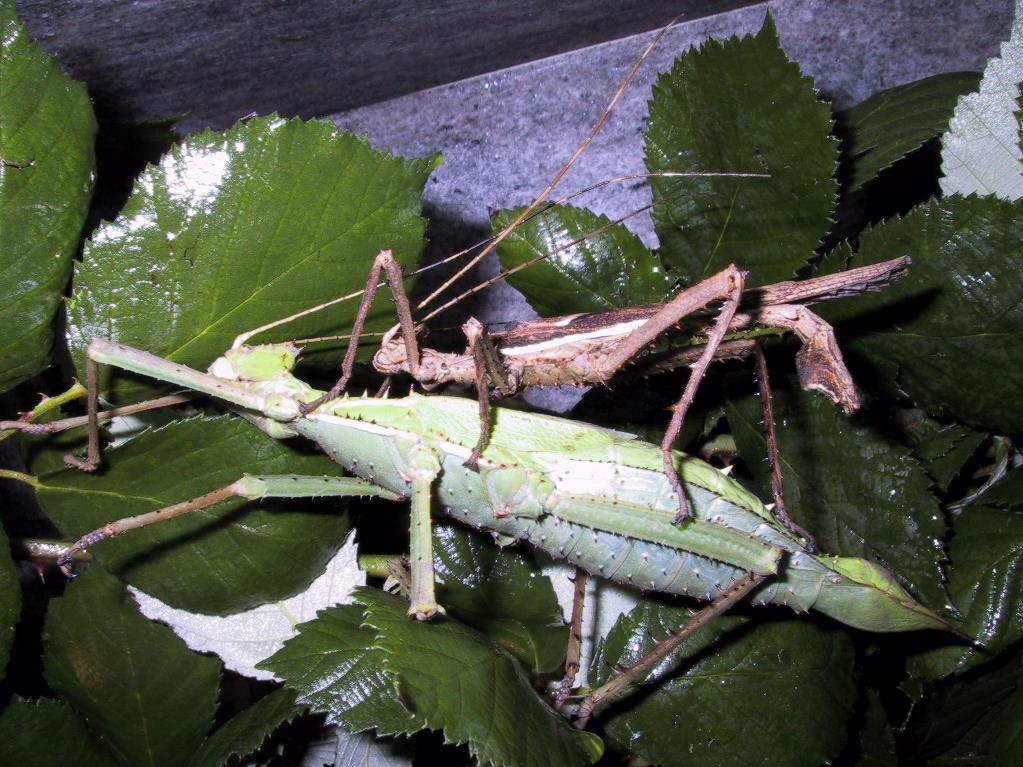Viewable


Location at the Zoo
Malayan Woods
Global Range
Indomalaya
Malaysian Stick Insect Jungle Wood Nymph
Heteropteryx dilatata
The Malaysian Stick Insect, also known as the Jungle Nymph, is one of the heaviest and most robust stick insects in the world. Females are notably large and broad, with a leaf-like, bright green body reaching 15 to 17 centimetres in length. Their appearance closely mimics thick tropical foliage, providing highly effective camouflage among understory plants. Males are slimmer, smaller—typically 10 to 12 centimetres—and display brownish or mottled colouring that resembles twigs or bark.
Despite being winged, females are flightless due to their large size, while males are capable of short gliding flights. Both sexes possess strong hind legs armed with sharp spines used defensively. In zoo settings, they are often admired for their impressive size and striking sexual dimorphism, serving as excellent ambassadors for insect camouflage and rainforest biodiversity.
Conservation Status: IUCN

Distribution
Occurs throughout Peninsular Malaysia, with additional populations reported in Borneo, including Sabah and Sarawak. The species is strongly tied to tropical forest ecosystems.
Habitat
Inhabits humid tropical rainforests, especially dense understory vegetation where broad leaves and stems create numerous hiding places. These insects are primarily nocturnal, staying motionless during the day to avoid detection and becoming active at night to feed.
Diet
This species is herbivorous, feeding on a variety of leaves. In the wild, they consume broadleaf rainforest plants, including shrubs and young trees. In captivity, they readily eat bramble, guava leaves, hibiscus, ivy, and other hardy greens. Their powerful jaws allow them to chew thick foliage.
Reproduction
Reproduction includes pronounced differences between male and female behaviour. After mating, females deposit large, seed-like eggs on the forest floor. These eggs resemble plant seeds and often lie partially buried in leaf litter for nine months or more before hatching. Nymphs emerge as miniature versions of adults and undergo numerous moults before reaching maturity, a process that may take a year or longer.
Adaptation
The Malaysian Stick Insect is an excellent example of rainforest camouflage. Females mimic thick leaves, while males resemble woody stems—both strategies reduce predation. When threatened, females can deliver a strong defensive kick using their heavily spined legs. Their stillness, colouring, and body shape make them nearly indistinguishable from vegetation. The species’ long developmental period and egg mimicry also help protect offspring in the dense forest floor environment.
Threats to Survival
Deforestation and habitat degradation are the primary threats, especially the conversion of rainforest to palm oil plantations and farmland. Habitat fragmentation isolates populations, reducing long-term viability. Collection for the pet trade has occurred but is now largely mitigated by successful captive breeding. Local microclimate changes caused by canopy removal may also impact survival, as the species depends on humidity and dense understory cover.












